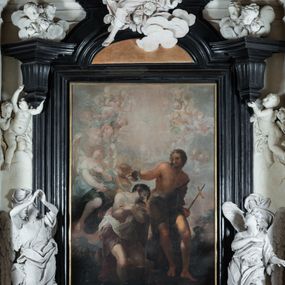
High altar
Place
Krzywaczka
Parish
Krzywaczka
Abstract
The high altar of the church in Krzywaczka was created in Władysław Druciak's sculpture workshop in 1914. The artist signed a contract with the then parish priest, Józef Nowak, in 1913. The Madonna of Częstochowa painting on the sliding panel was created by the painter Szczurowski, and altar works were finished by Józef Małek, a goldsmith. The altar was created in the Neo-Gothic style, reflecting medieval– gothic models and replicating old forms and ornaments, creating a new whole. The triaxial altar combines elements which are typical for Gothic architecture, such as openwork turrets crowned with pinnacles, fleuron ornaments and crockets, pointed arches, gables or traceries. Druciak's creative oeuvre is referred to as an example of historism in sacral sculpture from the beginning of the 20th century. The central niche of the altar in Krzywaczka houses a relief of the Holy Trinity, which is a direct reference to the invocation of the parish, whereas the smaller niches showcase the statues of St. Isidore, St. Ambrose and St. Dominic. The larger niches are devoted to the Polish patrons: St. Stanislaus and St. Adalbert, whereas the altar finial features a statue of Joseph with Infant Jesus.
Other works of this author
Persons related to work
Other works from this place
Other works from this year
Similar works
How to cite?
Maria Działo, "High altar", [in:] "The Sacred Lesser Poland Heritage", 2025, source: https://sdm.upjp2.edu.pl/en/works/high-altar-41















































